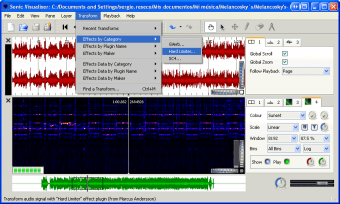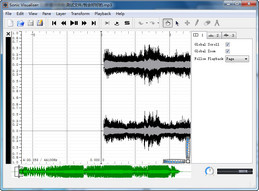
- #Sonic visualiser in virtual dj 8 full#
- #Sonic visualiser in virtual dj 8 software#
- #Sonic visualiser in virtual dj 8 plus#
- #Sonic visualiser in virtual dj 8 free#
There could be two variants, one as you have so far, focusing around 120. Imo the algorithm should work independently of 120. Continuing from there, instead of from 120.

What technique could be used? Using first two "bigger onset events", calculating time difference, from that getting first estimated bpm. This part could be generalized not focusing unnecessarily on 120 bpm area. Not sure it will works, but this is all can for now.
#Sonic visualiser in virtual dj 8 full#
do all this stuff for a full audio data, build tempo map, or compare resulted beats for getting some constant tempo if it is supposed to be constant. map this best to complex domain and get best match with the envelope, this would be a beat offset (i should probably also deal with tempo multiplications here) do invert FFT back, find best block offset, this will be general tempo do FFT again under autocorrelation outputs oversample 8x for better further resolution make it windowed for the mid tempo set as 120 bpm 2 octaves around (120 as best human noticable tempo) completely different tempos at different areas of the song, at the same it could be as different as is, but on some songs this can be multiplied tempos like 80 / 106 / 160įor now im building algorithm that do this directly using REAPER API (not sending anything to some 3rd party software).

varying tempo within some area like 128.130 close but not exact tempo like 129.98 bpm (for some songs Virtual DJ give same result) While Im getting some things to work, there are fw questions about how data should be handled. There would need to be improvements around how tempo envelopes and tempo markers work and related tools needs to be added.Ĭockos seems to avoid just adding stuff unless they can do something sensible and comprehensive with it so I’m guessing it’s not just going to appear in an update, if ever. The discussion is about audio tempo mapping for material with variable tempo.Ī decent implementation of this is not limited to a simple beat detection algorithm though. It works as long as the audio have a drum in it (even if it's not only drum) or some other rhythmic component starting from a '70 rock song, see my initial post) I don't know how precise it is and how much post-editing is needed then, but I've seen very good results (e.g. Logic can quickly detect tempo and create a tempo map. It's audio tempo mapping, and not for audio with a clear fixed click beginning to end - easy task then - but audio with variable tempo (as good music should be since tempo is a tool as much as harmony and melody. I'm asking for a one click integrated function with Reaper tempo map creation pretty much as Logic does.Īnd as said I'm not into midi. Taking its exported results back to Reaper, hoping those can be useful somehow in Reaper, directly or via some magical scripts. But you can use any VAMP plugins, it does not matter, anything which helps you. It would be same concept only using this time other Sonic Visualiser VAMP plugins, for beat detection for example.
#Sonic visualiser in virtual dj 8 plus#
The tempo map is generated automatically for you, plus the used key changes as well.įor sonic-annotator examples with Reaper you can check chordino examples.

#Sonic visualiser in virtual dj 8 free#
It can detect where the beats are from free playing and adjusts the tempo of the midi, without changing the original timing. With midi optimizer you can tempo map any freely played midi performance for example, anything not aligned to any tempo.
#Sonic visualiser in virtual dj 8 software#
A combination of sonic-annotator + Midi Optimizer can not be beaten, I guess, also not by any available other software (Logic and friends.) Why? I am not sure if Logic put the research results of Midi Optimizer into their software, if yes, maybe, otherwise clearly no. Not integrated, yes, what you can do is setting sonic-annotator (Sonic Visualiser for the command line) as an editor for Reaper, so opening an item there would process it.


 0 kommentar(er)
0 kommentar(er)
